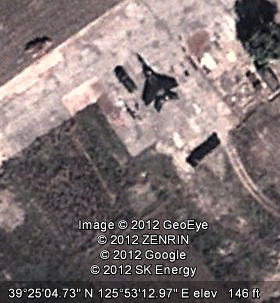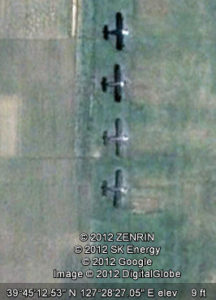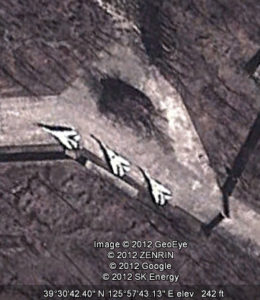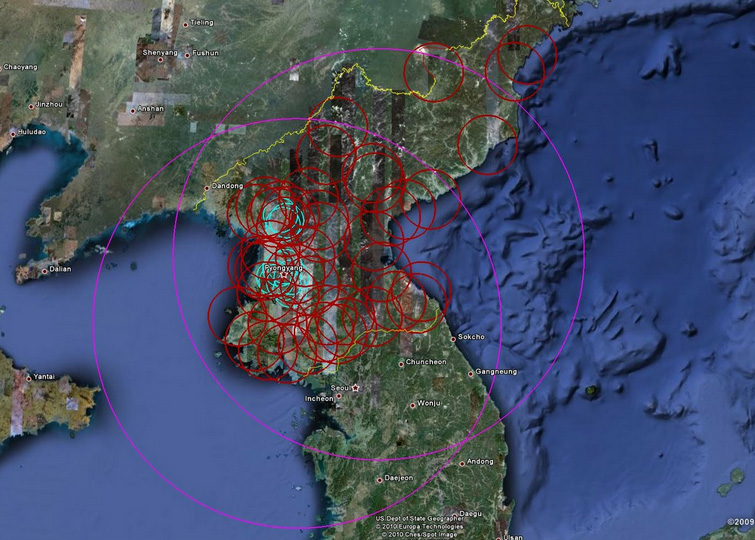The Peninsula
The Asymmetrical Challenges of North Korea’s Air Force

By Chad 0’Carroll
As South Korea evaluates a range of advanced fighter jets in preparation for an October decision on upgrading part of its air force, North Korean air force commanders are likely getting increasingly worried about their capacity to defend the skies of the DPRK. Although Pyongyang has long possessed a much larger air force than its southern neighbor, rudimentary weapons systems capabilities, a mainly vintage selection of aircraft, and inadequate levels of pilot training have all increasingly undermined its aerial capabilities. This problem will only be further compounded when the ROK receives its latest order of next generation fighters in 2016.
Estimates of the size of North Korea’s Air Force vary, but the Library of Congress estimates the DPRK possesses over 800 fighters and bombers in total. In addition, it owns a staggeringly high number of transport aircraft, including 318 fixed wing planes and 518 helicopters. However, while these numbers do significantly dwarf South Korea’s Air Force, the quality and age of North Korea’s aircraft reduces its threat level considerably.
Chronic fuel shortages have meant that pilots have been reported to have as little as 20 hours training per year, giving them little experiencing in either defensive or offensive aerial flight. In addition, North Korea’s moribund economy has meant it has long been unable to purchase modern jets of any substantial quantity, a problem that will continue even if the economic situation improves due to UN sanctions that prevent the legitimate sale of modern fighter jets. And while theoretically possessing a large air force, much of the equipment has been shown by satellite images to be in a state of decay, with inventory often stripped of parts, left in un-flyable condition.
All these factors help explain why during a recent Air-Force mobilization effort following the shelling of Yeonpyeong island, North Korea’s Air-Force reportedly fared extremely poorly, with pilots demonstrating sub-par flying skills, air craft performing poorly, and even several crashes and near misses taking place. So as South Korea looks forward to taking delivery of a further 60 next generation fighters, what is North Korea doing to improve its aerial capabilities moving forward?
Better Training
One new way North Korea seems to be attempting to improve its Air Force is through better training of its pilots, and focusing that training on its very best aircraft types. Following the death of Kim Jong-il, several reports emerged which said that the North Korean air force was flying far more training missions than was normal. During winter up to 650 training flights per day were recorded, well up from the 100 or so average throughout 2011. The training flights in the earlier part of 2012 were also reportedly more antagonistic than usual, with DPRK forces flying so close to the DMZ that South Korean Air Force reportedly had to scramble aircraft several times in response. These training flights also employed North Korea’s best inventory, its fleet of MiG-29 fighter jets and SU-25 close-air-support jets. This was a prudent choice given the vintage nature of the rest of its inventory, including many aircraft from the early 1950s and 1960s that could be easily destroyed by South Korean forces. It is possible that the increased flight frequency is linked to Kim Jong-un’s recent visit to a base housing one of North Korea’s advanced Mig-29 squadrons, a visit during which crew may have lobbied him about the need to increase training missions.
Asymmetric “Stealth” Capabilities
North Korea is very familiar with using asymmetric means to improve its capabilities, and its air-force is no different in this regard. Although many of its aircraft would not look out of place in aviation history museums, this does not mean that some of the older aircraft types do not have significant tactical value. One such aircraft is the Soviet built Antonov AN-2 (introduced 1947), the largest biplane ever designed. Capable of carrying at least 12 paratroopers, the AN-2’s biplane design has many interesting advantages, being able to take off and land on rough surface runways from very short distances (just 560ft required), fly very slowly (the stall speed is just 30mph), and as a result of its low speed flight capability, fly safely at extremely low altitude. Interestingly, its light airframe, canvas skin and single propeller engine also give it a surprisingly high degree of stealth capabilities. When coupled with its low flying capabilities, these characteristics make the AN-2 remarkably invisible to South Korean radars.
When considering that amateur pilot Mathius Rust was able to fly into Soviet airspace during the height of the Cold War and land successfully in Red Square with a similarly small prop powered aircraft, one can see the advantage the characteristics of the AN-2 provide. As such, these benefits provide North Korea with 270 relatively stealth aircraft that could fly low over the DMZ and allow the delivery of special-forces into South Korea without much chance of anything but visual detection.
Defensive Measures
Tunnels – Another way North Korea has been working to improve its capabilities over the past decade or so has been through ensuring its best capabilities are survivable. While the MiG-29 and SU-25 (and to a lesser extent the MiG-23) represent North Korea’s most modern aircraft types, the DPRK Air Force owns relatively low numbers of each model (reports suggest around 40 MiG-29s, 36 Su-25s and 40 MiG-23s). As a result, North Korea has taken precautions to ensure that in the event of war, many of its best assets will be protected both before and after missions.
Having much experience in deep tunneling, North Korea has consequently embellished a number of airports with subterranean aircraft storage facilities (most obvious at airports with no aircraft visible to satellite), with a handful even featuring underground runways which allow jets to take off out from mountains. A caveat though is that these measures are not watertight, because carefully aimed explosives can temporarily block entry and exit areas to tunnels, while deep penetrating weapons could potentially even cause significant damage to deeper parts of the tunnels.
Air Defense – In addition to its subterranean facilities, North Korea also possesses what one open source analyst has labeled “the most capable third-world strategic SAM (surface-to-air missile) network on paper.” Having over 30 early warning radar systems mainly consolidated towards the south, North Korea has a relatively dense air defense network – as can be seen in this extensive analysis. However, most of North Korea’s air defense systems are now dated with conflicts like the 1991 Iraq war illustrating how much of the DPRK air defense inventory was successfully overcome in other theaters.
But perhaps cognizant of aging infrastructure and its inability to purchase new fighters, North Korea has been reportedly investing resources in upgrading its air defense capabilities, with recent ROK intelligence suggesting that ground-to-air short range KN-06 testing has been successful. If true, this provides the DPRK with a much needed mobile boost to its air defenses – capable of hitting targets up to 150km away. But quite how many of these missiles North Korea has are as of yet unknown.
Conclusion
North Korea has a large but dated Air-Force. But at least for now, its fleet of modern attack planes stands at least a fighting chance against the current South Korean Air Force. However, it is important to remember that North Korea possesses around just one hundred of these aircraft in total. When South Korea receives its final batch of 60 next generation fighters in 2016, it will posses 120 next generation fighters – in addition to its relatively modern fleet of 100+ F16s. At this point, the best inventory of North Korea’s air force will be outnumbered by South Korean forces by nearly two to one. Of course this comparison does not even considering the likely substantial support the U.S. Air Force would provide in any conflict.
Unable to purchase new fighter aircraft, North Korea has had little choice but to train its air force better, protect its best assets, and rely on asymmetric means to counter South Korea’s increasingly powerful air force.
Chad 0’Carroll is the Director of Communications for the Korea Economic Institute. The views represented here are his own.



